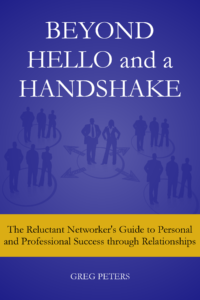 Welcome to the another in the weekly series of sneak peaks into my upcoming book Beyond Hello and a Handshake.
Welcome to the another in the weekly series of sneak peaks into my upcoming book Beyond Hello and a Handshake.
—————————————
“Before anything else, preparation is the key to success.”
~ Alexander Graham Bell
Bob seems like a cool guy.
You met him at the last business after-hours put on by the Chamber of Commerce in your town. You got to chatting while waiting in line for drinks. That turned into a longer conversation in which you both got the sense that this could be a great professional connection. You might even have a resource or two that you can place at his disposal.
What happens in the minutes, days, and weeks to come will define the success of this connection. So where should you go from here?
In the next few posts, we’ll cover the before, during, and after of a successful one-to one get-together. Today’s focus is on…
Before
- At the initial meeting – Exchange contact information. Whether it is a business card, email, text message, or whatever, you will need their contact information at some point in this process. Make sure you have it.
- As soon as possible after your initial meeting – Immediately if possible, schedule a time to get together. This doesn’t have to be overly complicated. “Bob, I had a great time chatting with you. Could we get together over coffee to continue the conversation? I want to hear more about what you are trying to achieve with ABC, LLC and who I might connect you with.” Obviously, if you can’t find a date to get together, then the rest of this timeline is a bit irrelevant.
- A day or two after the initial meeting – If you promised them something during that first conversation, be sure to deliver. Send the link to that article. Make that introduction. Look up that app you mentioned that will help them stay organized and get it into their inbox.
- At some point – Select a location for your meeting. Make sure it is conducive to good conversation and yet convenient for both of you. I prefer to work this out when I schedule the one-to-one, but there are some people who like to “play it by ear” and decide in the moment.
- One day before – Send a confirmation message. Make sure you include the time, date (and day), location, and your cell number in case there are any last minute emergencies. You might also include the purpose for the meeting (lunch, coffee, etc) and any topics you agreed to talk about. This would be a good place to use an email template to make sure none of the pieces is missing. If this is a “Blind Date” meeting (a first meeting set up by a third party), you should also include information on how they can identify you.
- The morning of – Collect your business cards, notebook and pen, and anything else you think you need to have with you. You can even throw in a brochure for your business, though I would keep it out of sight unless they specifically ask for it. Your bringing it out otherwise turns this from a one-to-one meeting into a sales call which could shut down this fledgling relationship.
- Ten minutes before you think you need to – Leave. In this situation, showing up late is completely unnecessary and ultimately disrespectful. Get there early or at least be prepared in case there is an unexpected delay. Getting there early gives you time to secure a seat, look over the menu, get your beverage, and be on the lookout for your friend.
- If you have a “hard stop” time – Set an alarm on your cell. It’s easy to get caught up in the conversation and you can easily exceed that time. Of course, let your table companion know that you have done this and why so they aren’t surprised.
- When they arrive – Stand to greet them, invite them to get their own beverage, read the menu, place their order. Then be sure to put your cell phone away. You might even tell them you are doing that so you won’t be disturbed. Leaving your phone in view sends them the subconscious signal that an incoming call could be more important than they are — not a signal you want to be giving off. Also, your making a point of doing so may encourage them to do the same.
Now you and Bob are ready to dig into a deeper conversation than you were able to have in a crowded banquet hall or wherever that first meeting took place. In our next section we will talk about what should be happening during that time.

